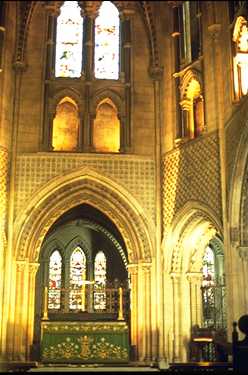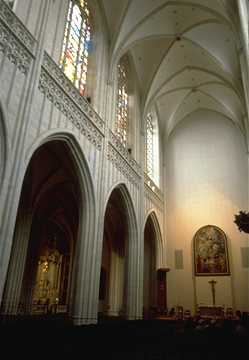The Sanctuary
The design of the old testament tabernacle and
its furnishings relate
to particular concepts
found in Christian worship. Two aspects of Jewish
worship especially influenced
Christian worship: the Passover ritual is
reflected in the Lord's Supper
(communion) and the synagogue service, with its
Bible reading, prayer and
sermon, formed a model for Christian services. To
see where our roots began,
take a tour of the Temple
Mount in Jerusalem.
In our virtual sanctuary, you can participate
in
worship by listening to music, reading hymns,
prayers, scriptures, sermons,
and the communion liturgy. For those who have the
free RealAudio®
plug-in, you can listen to hymns and sermons in
our Audio/Visual
Center. For those you want a visual
representation, visit our photos page, which includes images of
church interiors, altars, and stained
glass windows. Or, for more in-depth research, take a virtual tour of gothic cathedrals, a site which includes links to video, pictures, history, and information sites.
[History of the
Church] [Basic
Beliefs and Creeds] [Order
of Worship]
History of the Church
The
Ecole Initiative
The University of Evansville's ongoing project
to create a hypertext
encyclopedia of church history, it includes
translations of primary sources
to 1500, short essays, articles, images, and a
chronology with a geographical
cross-index.
Basic Beliefs
and Creeds
The
Augsburg Confession
This is the first of the great Protestant
Confessions. Most Lutheran
church bodies base their teachings upon this document.
The Heidelberg
Catechism
Written by Zacharias Ursinus and Caspar
Olevianus in Germany at the
time of the breaking of the peace of Augsburg in response to the Lutherans and at
the direction of Frederick the Elector. It is one of the principal documents of the Reformed
tradition.
Luther's 95 Theses
One of the most important documents in
western history, this is the defining statement of Martin Luther's
dispute with the Roman Catholic practice of selling indulgences.
What came to be known as the Protestant Reformation began with this document.
Prebsbyterian Statement of Faith
The Nicene Creed
Written during the 4th century A.D. in an
attempt to unify the Christian church under emperor Constantine. Iit is
the only statement of faith that is accepted by all three
major branches of Christianity including Protestant, Roman Catholic and Eastern Orthodox.
Official Statement of Fundamental Truths
From the Assemblies of God denomination, a simple outline of their faith.
Order of Worship
 
Tabernacle
Influence on Christian Worship
During the wanderings of the Children of Israel
through the forty years
in the wilderness God gave Moses explicit and
detailed instructions concerning
the building of the Tabernacle along with specific
instructions for the
order of worship within the Tabernacle: Exodus
Chapters 25-31.
Aspects of the Tabernacle design, the
furnishings and worship
services relate to particular concepts found in
the Christian worship.
For instance, the mercy seat, where the blood of
the sin offering was sprinkled
on the Day of Atonement (Yom Kippur), was
fulfilled perfectly for all who
believe on the sacrifice of the Lord Jesus Christ
whose blood was shed
on Calvary's cross for forgiveness of sins. The
table of shewbread representing
hospitality and fellowship with God was fulfilled
in Jesus Christ whose
body was broken for mankind.By faith we partake of
Jesus' body in the communion
where bread and wine or grape juice (the blood of
the grape) are consumed.
The laver, or brass basin of water where the
sacrificial animal was washed
before being sacrificed is representative of
Christians "washing by the
Word" and of sanctification or cleansing from the
former sinful life. This
is also represented in the washing of the feet of
the disciples' feet by
Jesus, symbolizing our need to undergo a daily
review of our lives and
the cleansing through repentance for un-Christlike
actions, attitudes and
attributes. Additionally, this "washing of the
feet" or sanctification
represents the cleansing of the animal before
sacrifice, or in the case
of Christians cleansing before the giving of
ourselves in a life of sacrifice
to the Lord God.
The "Holy of Holies", the central part of
the tabernacle and later
of the temple was enclosed by a thick woven
curtain or "veil". Only the
chief priest could enter the Holy of Holies on the
Day of Atonement, and
if the priest were unworthy to enter because of
sin he would be struck
dead. For this reason he wore bells on the hem of
his robe and a rope around
his ankle so that his body could be drug from the
Holy of Holies since
no one could enter to carry out the body. On the
day of Jesus' crucifixion,
Matthew 27:51, there was an earthquake and the veil of the temple before
the Holy of Holies was torn into two pieces from
top to bottom . This signified
that because of Jesus' sacrificial death all
believers now enter the Holy
of Holies, or personal fellowship with God. The
Holy Spirit now indwells
each believer and our bodies are the temple of the
Holy Spirit, I Corinthians 3:16
Return
The Nicene Creed
I believe in one God, the Father Almighty, Maker of heaven and earth, and of all things visible and invisible.
And in one Lord Jesus Christ, the only-begotten Son of God, begotten of the Father before all worlds; God of God, Light of Light, very God of very God; begotten, not made, being of one substance with the Father, by whom all things were made.
Who, for us men for our salvation, came down from heaven, and was incarnate by the Holy Spirit of the virgin Mary, and was made man; and was crucified also for us under Pontius Pilate; He suffered and was buried; and the third day He rose again, according to the Scriptures; and ascended into heaven, and sits on the right hand of the Father; and He shall come again, with glory, to judge the quick and the dead; whose kingdom shall have no end.
And I believe in the Holy Ghost, the Lord and Giver of Life; who proceeds from the Father and the Son; who with the Father and the Son together is worshipped and glorified; who spoke by the prophets.
And I believe one holy catholic and apostolic Church. I acknowledge one baptism for the remission of sins; and I look for the resurrection of the dead, and the life of the world to come. Amen.
Return
|